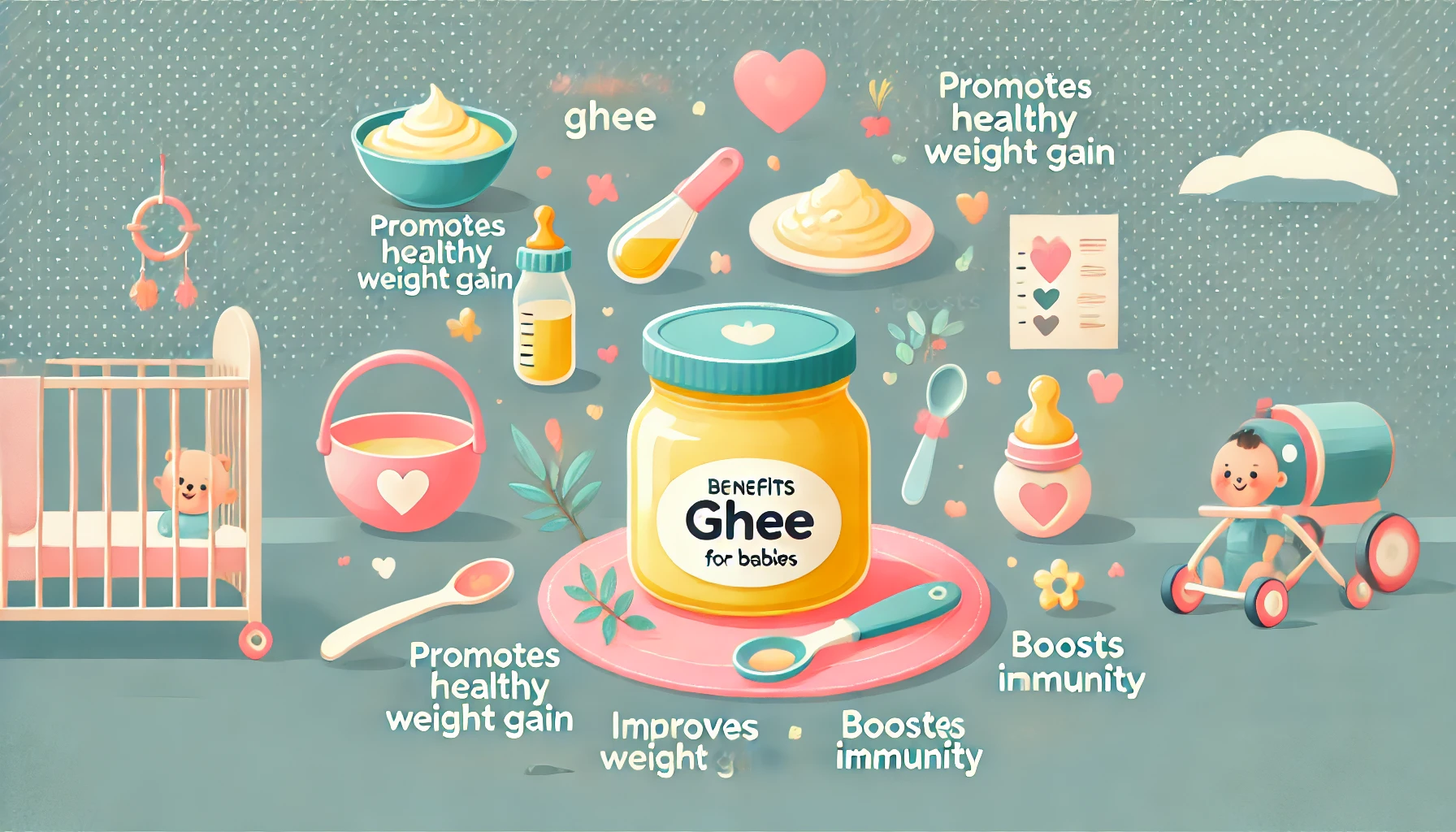- You have no items in your shopping cart
- Subtotal: ₹0.00
Ghee for Babies: Benefits, When to Start, and How to Use
Ghee, also known as clarified butter, has been a staple in Indian households for centuries. Its numerous health benefits make it a popular choice for people of all ages, and babies are no exception. In this detailed guide, we will explore the benefits of cow ghee and buffalo ghee for babies, suggest when you can start introducing ghee into their diet, and provide tips on how to incorporate ghee in baby meals. We will also delve into the differences between cow and buffalo ghee and why GheeStore’s ghee is a great choice for your baby.
What is Ghee?
Ghee is clarified butter made by heating butter to remove milk solids and water. What’s left behind is a golden, aromatic liquid rich in healthy fats and nutrients. Ghee is particularly valued in Ayurvedic practices for its ability to nourish the body and aid digestion. Its versatility and health benefits make it an ideal choice for infants and toddlers.
Why is Ghee Good for Babies?
Ghee is a rich source of essential nutrients that are crucial for a baby’s growth and development. Here are some of the key benefits of introducing ghee to your baby’s diet:
- Rich Source of Healthy Fats: Ghee contains medium-chain fatty acids (MCFAs), which are easier to digest and help in energy production. These fats are essential for brain development and the overall growth of babies.
- Boosts Immunity: Ghee is rich in antioxidants and fat-soluble vitamins like A, D, E, and K. These nutrients help strengthen your baby’s immune system, making them less prone to infections and illnesses.
- Aids in Digestion: Ghee stimulates the secretion of digestive enzymes, which can help babies absorb nutrients more effectively. It also contains butyrate, a short-chain fatty acid that promotes a healthy gut lining.
- Promotes Weight Gain: For babies who need to gain weight, ghee is a healthy way to add calories to their diet. The healthy fats in ghee help in healthy weight gain without causing digestive issues.
- Lubricates Joints and Muscles: The fats in ghee help lubricate the joints and muscles of babies, promoting their physical development as they start crawling, standing, and walking.
- Good for Brain Development: The Omega-3 and Omega-9 fatty acids found in ghee are vital for cognitive development. Regular consumption of ghee can aid in better memory and focus as your baby grows.
When Can You Start Giving Ghee to Babies?
The right time to introduce ghee into your baby’s diet can vary depending on their digestive system’s development. Here’s a general guideline:
- 6 months: Once you start introducing solid foods into your baby’s diet, you can add a small amount of ghee to their meals. This is a good time to test whether your baby can tolerate ghee. Start with 1/4 teaspoon in their food and observe for any allergic reactions.
- 8-10 months: By this time, you can increase the amount of ghee to about 1/2 to 1 teaspoon daily, mixed into their meals.
- 12 months and above: After a year, you can safely add 1-2 teaspoons of ghee to your baby’s diet daily. At this stage, ghee can be added to a variety of foods, including soups, porridges, and chapatis.
Cow Ghee vs. Buffalo Ghee for Babies
While both cow and buffalo ghee offer health benefits, they have different properties. Let’s take a closer look at the benefits and differences:
Cow Ghee for Babies:
- Lighter and Easier to Digest: Cow ghee has a lower fat content compared to buffalo ghee, making it easier for babies to digest. This is particularly important for babies under one year, as their digestive systems are still developing.
- Rich in Omega-3 and Omega-6: Cow ghee is an excellent source of Omega-3 and Omega-6 fatty acids, which are essential for brain development and growth.
- Good for Immunity: Cow ghee is packed with Vitamin A and antioxidants, which help boost the immune system, keeping your baby healthy.
Buffalo Ghee for Babies:
- High in Fat Content: Buffalo ghee contains more fat than cow ghee, making it ideal for babies who need to gain weight. However, due to its higher fat content, it is harder to digest and should be introduced only after 12 months.
- Longer Shelf Life: Buffalo ghee has a longer shelf life and can be stored for extended periods without refrigeration.
- More Calorific: If your baby requires more calories for growth, buffalo ghee can be a good option to add to their diet.
How to Introduce Ghee to Babies
Here are a few simple ways to include ghee in your baby’s diet:
- Ghee Rice: Mix a small amount of ghee with soft, well-cooked rice for a nutritious and easy-to-digest meal.
- Dal with Ghee: Add a teaspoon of ghee to mashed lentils or dal. This makes a protein-rich, nourishing meal for your baby.
- Vegetable Purees: Add a little ghee to vegetable purees or mashed potatoes to enhance flavor and provide healthy fats.
- Porridges: Add a dollop of ghee to porridges made from oats, ragi, or other grains. Ghee enhances both the taste and nutritional value of these porridges.
- Chapati or Paratha: Once your baby starts eating chapatis or parathas, spread a thin layer of ghee on top to make them softer and more nutritious.
- Soups: Add a teaspoon of ghee to vegetable or chicken soups for added richness and flavor.
Safety Tips When Using Ghee for Babies
While ghee is safe for babies, it is essential to use it in moderation. Here are a few safety tips to consider:
- Introduce Gradually: Always start with small amounts of ghee to see how your baby reacts. Some babies might be sensitive to fats, and introducing too much ghee at once could upset their stomach.
- Consult Your Pediatrician: If your baby has a history of food allergies or intolerance, consult your pediatrician before introducing ghee into their diet.
- Use Pure Ghee: Ensure that the ghee you’re using is pure and free from additives or preservatives. Opt for organic, grass-fed cow ghee to maximize the nutritional benefits for your baby.
Ghee for Babies with Lactose Intolerance
One common concern is whether babies with lactose intolerance can consume ghee. The good news is that ghee contains very minimal lactose because it’s made by removing milk solids during the clarification process. However, it’s still advisable to consult your pediatrician before giving ghee to a baby with lactose intolerance.
Ghee Massage for Babies
In addition to being a nutritious food, ghee is also commonly used in traditional Indian massages for babies. Ghee massages are believed to help strengthen the muscles and bones and improve circulation. Warm a small amount of ghee and gently massage it onto your baby’s skin. Ghee can also be used to massage the scalp and help with cradle cap.
GheeStore: The Best Ghee for Babies
At GheeStore, we pride ourselves on providing 100% pure, organic ghee made from the milk of grass-fed cows. Our ghee is free from preservatives and additives, making it the perfect choice for your baby’s delicate digestive system. We also offer buffalo ghee for parents looking to introduce a richer, more calorific option.
You can explore our wide range of ghee products at GheeStore and order online for delivery directly to your home. We guarantee the quality and purity of our ghee, ensuring that your baby gets only the best.
Conclusion
Ghee is a nutrient-packed, versatile food that offers numerous health benefits for babies. Whether it’s cow ghee for its digestibility or buffalo ghee for its high caloric content, introducing ghee into your baby’s diet can help promote healthy growth and development. Start with small amounts, and gradually increase as your baby grows. Remember to choose pure, organic ghee from trusted sources like GheeStore to ensure your baby gets the best nutrition possible.




